IT is under arrangement to restore the ancient Inwa palace tooth-relic building to its original state, referring to the painting in Parabaik, said archaeologist and writer Bo Shake.
One donor will fund it and it has been submitted to the Department of Archaeology and National Museums to design and rebuild it to its original state as per Parabaik.
“It has been submitted to the archaeological department to renovate the tooth-relic building under the law to the style shown in the Parabaik painting.

IT is under arrangement to restore the ancient Inwa palace tooth-relic building to its original state, referring to the painting in Parabaik, said archaeologist and writer Bo Shake.
One donor will fund it and it has been submitted to the Department of Archaeology and National Museums to design and rebuild it to its original state as per Parabaik.
“It has been submitted to the archaeological department to renovate the tooth-relic building under the law to the style shown in the Parabaik painting.
We will start working immediately after receiving permission from the department. We will work together with the archaeology department for their advice and technology. Sayagyi U Win Maung will draw the designs based on the Parabaik painting,” he said.
It is a rare tooth-relic building in the palace and a pagoda where people can learn about the Buddhist beliefs and custom of successive ancient Myanmar Kings.
By reconstructing the building, future generations will be able to observe the culture and customs of the ancient kings, he said. The Inwa tooth-relic building is between the Ywaytawyu Gate and the Red Gate of the palace and is located in the innermost part of the three layers of the wall. The only tooth-relic pagoda in Inwa has a very beautiful staircase with intricate reliefs with stucco and is said to be the most beautiful rare work. — MT/ZN
Source: The Global New Light of Myanmar
IT is under arrangement to restore the ancient Inwa palace tooth-relic building to its original state, referring to the painting in Parabaik, said archaeologist and writer Bo Shake.
One donor will fund it and it has been submitted to the Department of Archaeology and National Museums to design and rebuild it to its original state as per Parabaik.
“It has been submitted to the archaeological department to renovate the tooth-relic building under the law to the style shown in the Parabaik painting.
We will start working immediately after receiving permission from the department. We will work together with the archaeology department for their advice and technology. Sayagyi U Win Maung will draw the designs based on the Parabaik painting,” he said.
It is a rare tooth-relic building in the palace and a pagoda where people can learn about the Buddhist beliefs and custom of successive ancient Myanmar Kings.
By reconstructing the building, future generations will be able to observe the culture and customs of the ancient kings, he said. The Inwa tooth-relic building is between the Ywaytawyu Gate and the Red Gate of the palace and is located in the innermost part of the three layers of the wall. The only tooth-relic pagoda in Inwa has a very beautiful staircase with intricate reliefs with stucco and is said to be the most beautiful rare work. — MT/ZN
Source: The Global New Light of Myanmar
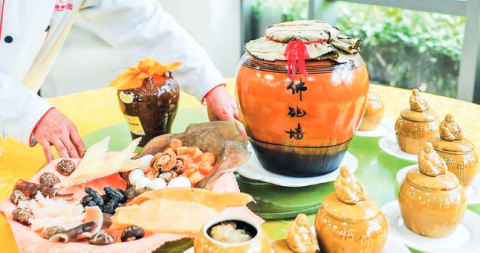
FOTIAOQIANG, also known as “Buddha Jumps over the Wall”, is a renowned Fujian dish with a rich history and complex preparation. Legend suggests the aroma of the dish’s stew caused a meditating Buddha to leap over a temple wall, inspiring the name. Traditionally reserved for elite banquets, it combines luxury ingredients like abalone, sea cucumber, and aged wine, creating a harmonious and flavourful broth. The dish requires days of preparation, making it rare and often only available by reservation.
FOTIAOQIANG, also known as “Buddha Jumps over the Wall”, is a renowned Fujian dish with a rich history and complex preparation. Legend suggests the aroma of the dish’s stew caused a meditating Buddha to leap over a temple wall, inspiring the name. Traditionally reserved for elite banquets, it combines luxury ingredients like abalone, sea cucumber, and aged wine, creating a harmonious and flavourful broth. The dish requires days of preparation, making it rare and often only available by reservation.
However, the rise of China’s ready-to-eat food industry has made Fotiaoqiang more accessible. Companies like Fujian Hydewin Marine Science and Technology have automated production lines that efficiently prepare and package the dish. With an annual output of 12 million servings, pre-made Fotiaoqiang is now affordable and available worldwide, especially to overseas Chinese communities.
While some chefs, like Yang Weihua, mourn the loss of traditional craftsmanship, the mass production of Fotiaoqiang is seen as a way to preserve heritage and introduce the dish to a broader audience. — Xinhua
Source: The Global New Light of Myanmar
FOTIAOQIANG, also known as “Buddha Jumps over the Wall”, is a renowned Fujian dish with a rich history and complex preparation. Legend suggests the aroma of the dish’s stew caused a meditating Buddha to leap over a temple wall, inspiring the name. Traditionally reserved for elite banquets, it combines luxury ingredients like abalone, sea cucumber, and aged wine, creating a harmonious and flavourful broth. The dish requires days of preparation, making it rare and often only available by reservation.
However, the rise of China’s ready-to-eat food industry has made Fotiaoqiang more accessible. Companies like Fujian Hydewin Marine Science and Technology have automated production lines that efficiently prepare and package the dish. With an annual output of 12 million servings, pre-made Fotiaoqiang is now affordable and available worldwide, especially to overseas Chinese communities.
While some chefs, like Yang Weihua, mourn the loss of traditional craftsmanship, the mass production of Fotiaoqiang is seen as a way to preserve heritage and introduce the dish to a broader audience. — Xinhua
Source: The Global New Light of Myanmar
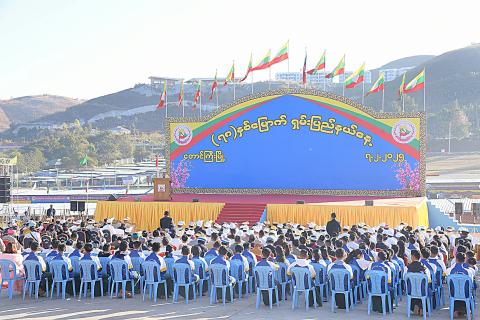
State Administration Council Member Union Minister for Border Affairs Lt-Gen Yar Pyae, accompanied by council members, attended the 78th Anniversary Shan State Day in Taunggyi yesterday.
During the celebration, the Union Minister read the message from SAC Chairman Prime Minister Senior General Thadoe Maha Thray Sithu Thadoe Thiri Thudhamma Min Aung Hlaing for the 78th Shan State Day. Shan State Chief Minister U Aung Aung then delivered a speech.
State Administration Council Member Union Minister for Border Affairs Lt-Gen Yar Pyae, accompanied by council members, attended the 78th Anniversary Shan State Day in Taunggyi yesterday.
During the celebration, the Union Minister read the message from SAC Chairman Prime Minister Senior General Thadoe Maha Thray Sithu Thadoe Thiri Thudhamma Min Aung Hlaing for the 78th Shan State Day. Shan State Chief Minister U Aung Aung then delivered a speech.
SAC member Union Minister Lt-Gen Yar Pyae and SAC Members Porel Aung Thein, Dr Ba Shwe, Khun San Lwin, Union Ministers Dr Soe Win, Jeng Phang Naw Taung, Khun Thant Zaw Htoo, Chief Minister U Aung Aung and Eastern Command Commander MajGen Zaw Min Latt inaugurated the ceremony and explored the exhibition booths displaying traditional ethnic cuisines, departmental booths, and MSME booths.
Afterwards, a ceremony was held at City Hall to award certificates of honour. The Union Minister and SAC members presented outstanding awards for management (first, second and third class) to 44 recipients and outstanding awards for security and rule of law to 12 recipients.
Union Minister Lt-Gen Yar Pyae donated solar panels and basic foodstuff worth K53 million for staff and people of Shan State and Union Minister Jeng Phang Naw Taung donated sports gear to the relevant officials.
Moreover, the Shan State chief minister presented out standing awards for security and the rule of law (third class) and awards for livestock breeding (first and third classes) and awards for social (first class); and the Shan State chief justice, state ministers and the secretary of the Shan State government presented outstanding awards for social (first, second, third classes) and sports (third class). — MNA/KTZH
Source: The Global New Light of Myanmar
State Administration Council Member Union Minister for Border Affairs Lt-Gen Yar Pyae, accompanied by council members, attended the 78th Anniversary Shan State Day in Taunggyi yesterday.
During the celebration, the Union Minister read the message from SAC Chairman Prime Minister Senior General Thadoe Maha Thray Sithu Thadoe Thiri Thudhamma Min Aung Hlaing for the 78th Shan State Day. Shan State Chief Minister U Aung Aung then delivered a speech.
SAC member Union Minister Lt-Gen Yar Pyae and SAC Members Porel Aung Thein, Dr Ba Shwe, Khun San Lwin, Union Ministers Dr Soe Win, Jeng Phang Naw Taung, Khun Thant Zaw Htoo, Chief Minister U Aung Aung and Eastern Command Commander MajGen Zaw Min Latt inaugurated the ceremony and explored the exhibition booths displaying traditional ethnic cuisines, departmental booths, and MSME booths.
Afterwards, a ceremony was held at City Hall to award certificates of honour. The Union Minister and SAC members presented outstanding awards for management (first, second and third class) to 44 recipients and outstanding awards for security and rule of law to 12 recipients.
Union Minister Lt-Gen Yar Pyae donated solar panels and basic foodstuff worth K53 million for staff and people of Shan State and Union Minister Jeng Phang Naw Taung donated sports gear to the relevant officials.
Moreover, the Shan State chief minister presented out standing awards for security and the rule of law (third class) and awards for livestock breeding (first and third classes) and awards for social (first class); and the Shan State chief justice, state ministers and the secretary of the Shan State government presented outstanding awards for social (first, second, third classes) and sports (third class). — MNA/KTZH
Source: The Global New Light of Myanmar

The cultural heritage of a country is often of special interest to international travellers. In the Bagan region and the hilly areas, foreign tourists are accustomed to drinking green tea and tea salad.
The cultural heritage of a country is often of special interest to international travellers. In the Bagan region and the hilly areas, foreign tourists are accustomed to drinking green tea and tea salad.
Tea has become popular in Asia and is consumed as green tea in Myanmar, China, India, Japan, South Korea, some ASEAN countries, and European nations. Tea leaves are processed both dried and fermented to be used in boiling water for drinking.
Although herbal tea is consumed and used for medicinal purposes in Europe and Asia, Myanmar has been using it for drinking, eating, and medicinal purposes since the Konbaung of Myanmar’s monarchical era. It is noteworthy that Myanmar is the only country where tea is consumed in the form of a salad.
A historical researcher said: “Stone inscription in the Konbaung era shows Myanmar has been using green tea used in boiling water for drinking. The traditional Myanmar Atar Thingyan festival, which is a heritage of Myanmar culture, has been recognized as the first intangible cultural heritage of humanity in Myanmar. If Myanmar’s tea is recognized as a World Cultural Heritage, the value of tea will increase, which is a matter of pride and great joy.”
Tea is primarily planted in hilly regions of Myanmar. The characteristics, colour, texture, aroma, and taste of tea tend to vary depending on the climate and environment. Since the Konbaung era, tea has been a traditional Myanmar meal. Currently, a traditional culture of serving tea salad and green tea to guests is thriving both in urban and rural areas of Myanmar.
Generally, tea can help reduce blood cholesterol levels, lower hypertension, and improve heart health. Its antioxidants may also help prevent certain intestinal diseases to ease tiredness.
The tea leaf salad is consumed with peanuts, sesame, fried shallots, dried shrimp, garlic, and chilli peppers. Moreover, it is also enjoyed with various combinations such as tomato, thinly sliced cabbage, tender papaya leaves and boiled maize.
The cultural heritage of a country is often of special interest to international travellers. In the Bagan region and the hilly areas, foreign tourists are accustomed to drinking green tea and tea salad. By promoting Myanmar’s traditional tea as an integral part of the world’s cultural heritage, there are opportunities to increase production and expand the market, with promising prospects ahead. — Thitsa (MNA)/TTA
Source: The Global New Light of Myanmar
The cultural heritage of a country is often of special interest to international travellers. In the Bagan region and the hilly areas, foreign tourists are accustomed to drinking green tea and tea salad.
Tea has become popular in Asia and is consumed as green tea in Myanmar, China, India, Japan, South Korea, some ASEAN countries, and European nations. Tea leaves are processed both dried and fermented to be used in boiling water for drinking.
Although herbal tea is consumed and used for medicinal purposes in Europe and Asia, Myanmar has been using it for drinking, eating, and medicinal purposes since the Konbaung of Myanmar’s monarchical era. It is noteworthy that Myanmar is the only country where tea is consumed in the form of a salad.
A historical researcher said: “Stone inscription in the Konbaung era shows Myanmar has been using green tea used in boiling water for drinking. The traditional Myanmar Atar Thingyan festival, which is a heritage of Myanmar culture, has been recognized as the first intangible cultural heritage of humanity in Myanmar. If Myanmar’s tea is recognized as a World Cultural Heritage, the value of tea will increase, which is a matter of pride and great joy.”
Tea is primarily planted in hilly regions of Myanmar. The characteristics, colour, texture, aroma, and taste of tea tend to vary depending on the climate and environment. Since the Konbaung era, tea has been a traditional Myanmar meal. Currently, a traditional culture of serving tea salad and green tea to guests is thriving both in urban and rural areas of Myanmar.
Generally, tea can help reduce blood cholesterol levels, lower hypertension, and improve heart health. Its antioxidants may also help prevent certain intestinal diseases to ease tiredness.
The tea leaf salad is consumed with peanuts, sesame, fried shallots, dried shrimp, garlic, and chilli peppers. Moreover, it is also enjoyed with various combinations such as tomato, thinly sliced cabbage, tender papaya leaves and boiled maize.
The cultural heritage of a country is often of special interest to international travellers. In the Bagan region and the hilly areas, foreign tourists are accustomed to drinking green tea and tea salad. By promoting Myanmar’s traditional tea as an integral part of the world’s cultural heritage, there are opportunities to increase production and expand the market, with promising prospects ahead. — Thitsa (MNA)/TTA
Source: The Global New Light of Myanmar
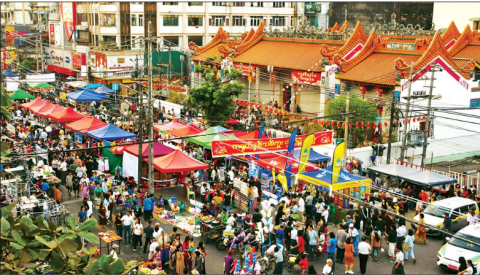
THE opening ceremony of the funfair and festival market for the Chinese New Year celebration, held yesterday evening on the main road in Latha Township, Yangon, was inaugurated by the chairman of the Kyauktada District Administration Body and officials from Chinese temples, who cut the ribbon and watched a performance of traditional Chinese cultural dances.
THE opening ceremony of the funfair and festival market for the Chinese New Year celebration, held yesterday evening on the main road in Latha Township, Yangon, was inaugurated by the chairman of the Kyauktada District Administration Body and officials from Chinese temples, who cut the ribbon and watched a performance of traditional Chinese cultural dances.
The Chinese New Year market features a wide range of cosmetics, consumer goods, and foods, as well as traditional lion and dragon dances, song performances by famous singers, boat rides, children’s playgrounds, and photo opportunities. The market will be held from 25 to 31 January, according to reports. — Ko Ko Zaw-MNA/TH
Source: The Global New Light of Myanmar
THE opening ceremony of the funfair and festival market for the Chinese New Year celebration, held yesterday evening on the main road in Latha Township, Yangon, was inaugurated by the chairman of the Kyauktada District Administration Body and officials from Chinese temples, who cut the ribbon and watched a performance of traditional Chinese cultural dances.
The Chinese New Year market features a wide range of cosmetics, consumer goods, and foods, as well as traditional lion and dragon dances, song performances by famous singers, boat rides, children’s playgrounds, and photo opportunities. The market will be held from 25 to 31 January, according to reports. — Ko Ko Zaw-MNA/TH
Source: The Global New Light of Myanmar
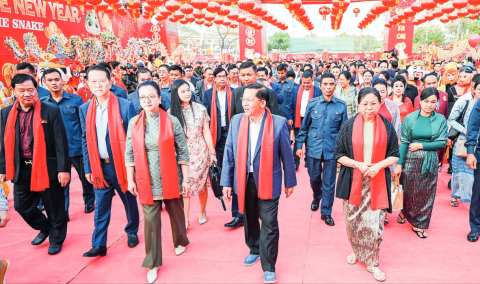
Myanmar seeks to build trustworthy and friendly ties with neighbouring China
Myanmar seeks to build trustworthy and friendly ties with neighbouring China
Senior General Min Aung Hlaing expressed his aspiration to further strengthen the China-Myanmar relationship and deepen the bond of friendship between the peoples of both nations.
A ceremony to organize the Chinese New Year celebration in the Year of Snake for 2025 took place at the National Indoor Stadium I in Thuwunna in Yangon yesterday afternoon, attended by Chairman of the State Administration Council Prime Minister Senior General Min Aung Hlaing and his wife Daw Kyu Kyu Hla.
The Senior General and his wife were warmly welcomed by Chinese Ambassador to Myanmar Ms Ma Jia and distinguished guests.
Union Ministers U Tin Oo Lwin, U Min Naung and U Tun Ohn, Yangon Region Chief Minister U Soe Thein, the minister-counsellors of the Chinese Embassy, the patron of Myanmar-China Buddhist and Cultural Exchange Association, officials from the Interfaith Dialogue Group, the chair of Myanmar-China Chamber of Commerce, the chair of Yunnan Social Welfare Association and chairs of other Chinese association cut the ribbon to open the ceremony.
The troupe of eight lions paid respect to the Senior General and his wife and the Chinese Ambassador with towels to mark the Chinese New Year.
The Senior General and the Chinese Ambassador pressed the button to launch the New Year festival.
A Shaolin monk extended the New Year greetings to strengthen China-Myanmar friendly ties. The Senior General, his wife and attendees enjoyed the Shaolin Kung Fu demonstration.
The Senior General and his wife offered Buddha images and a flower basket to the Shaolin monks who returned gifts.
The Senior General, his wife and the Chinese Ambassador posed for documentary photos together with attendees.
The Senior General and his wife presented cash awards to the entertainment troupes.
They visited the Chinese traditional cultural booths from Chinatown and Chinese traditional food booths.
At the dinner to mark the Year of Snake, the Senior General and his wife, and the Chinese Ambassador painted the traditional Chinese lion statue. Then, the traditional Chinese lion dance troupe performed dances.
Speaking on the occasion, the Senior General said that it is understood that the snake symbolizes wisdom, strategic transformation, renewal, growth, and deep insight. It is believed that these qualities will enable greater progress and transformation, fulfilling the aspirations of the Chinese people.
Due to centuries-old relations and a long-standing shared border, China and Myanmar have been able to establish strong ties, including kinship-based relationships, strategic cooperative partnerships, and efforts to build a community with shared future benefits. Moving forward, the Senior General expressed his aspiration to further strengthen the China-Myanmar relationship and deepen the bond of friendship between the peoples of both nations.
Regarding Myanmar, it was expressed that due to the implementation of Myanmar-China economic corridor projects, Myanmar attaches importance to collaboration with China for peaceful development and mutual benefits. Myanmar aims to enhance the momentum of ongoing projects with China and continue to establish itself as a trustworthy and friendly neighbouring country to China.
In November of last year, the Senior General recounted that he visited the People’s Republic of China at the invitation of the Chinese government. During the trip, he attended the Mekong Summit and related meetings and held separate discussions with the Chinese Premier and other leaders from ASEAN countries who participated in the event. During discussions, the Chinese Premier reaffirmed the matters previously confirmed during the Chinese Foreign Minister’s visit to Myanmar. These include China’s full support for Myanmar’s internal peace and stability, endorsement of Myanmar’s efforts following the five-point roadmap of the State Administration Council, and assistance concerning the elections. Moreover, discussions emphasized enhancing multifaceted cooperation between the two countries, strengthening China-Myanmar relations, and fostering greater political trust.
It was also highlighted that China’s confirmations and assistance reflect its status as a steadfast friend of Myanmar. Myanmar expressed gratitude to China for its unwavering stance and support.
China firmly supports Myanmar’s independence and sovereignty and values its assistance in promoting stability and peace. Myanmar expresses its gratitude to the Chinese government and all Chinese citizens for their continued support. Moreover, Myanmar requests China’s continued cooperation in its peace processes and efforts toward national development.
Diplomatic relations between Myanmar and China will have reached a milestone of 75 years on 8 June this year. China and Myanmar have supported each other in various matters since the establishment of their diplomatic ties.
Both domestic and international groups do not welcome the friendly and close relations between the two nations and they employ various methods to instigate Myanmar and China. Therefore, the authorities and citizens of both countries must remain vigilant and committed to safeguarding their mutual ties.
In light of this, the people of Myanmar, Chinese-Myanmar associations within Myanmar, Chinese descendants in Myanmar, and Chinese citizens working in Myanmar should collaborate with a sense of patriotism and mutual harmony, living together in unity.
Then, the Senior General and his wife and the Chinese Ambassador to Myanmar exchanged commemorative gifts to mark the 2025 Snake Year of the Chinese New Year.
Afterwards, the Chinese Ambassador to Myanmar delivered New Year greetings, stating that the Chinese New Year is the most significant festival for the Chinese people and expressing great joy in welcoming the Year of the Snake. Chinese individuals have actively integrated into the larger family of Myanmar, which is home to various ethnic groups, and have become important contributors and participants in Myanmar’s economic and social development, as well as in fostering China-Myanmar friendship. Throughout this year, both nations have maintained positive progress in mutual exchanges and collaborations in various sectors, including culture, tourism, and religious affairs. This year marks the 75th anniversary of diplomatic relations between China and Myanmar. With the attention and guidance of the leaders of both countries, the comprehensive and strategic partnership between the two nations has yielded fruitful results, fostering new developments and creating numerous opportunities for the development of both peoples.
It is believed that in the coming year, by joining hands, they can continue contributing to the construction of a shared future and a harmonious community for China and Myanmar. Together, they will build a beautiful future for both nations, ensuring mutual development, prosperity, and peace. With this in mind, best wishes are extended for continued growth, harmony, and lasting peace between the two countries.
Afterwards, the Senior General and his wife joined attendees of the ceremony to partake in a dinner reception held in honour of the Chinese New Year.
During the dinner, entertainment was provided by a special cultural and literary performance group from China, including martial arts demonstrations by Shaolin monks. Under the Directorate of Public Relations and Psychological Warfare, the Myawady Entertainment Troupe and artists showcased dances, musical performances, and songs promoting Sino-Myanmar friendship. Chinese cultural troupes presented traditional Chinese songs and music performances, while external artists entertained with various songs. During the performances, a speech was delivered celebrating Myanmar’s traditional New Year water festival (Thingyan), which was the first to be inscribed on UNESCO’s Intangible Cultural Heritage list. In recognition of this honour, the Myawady Band performed the Thingyan song “Khit Lay Khit” (Four Eras).
The Senior General, his wife and the Chinese Ambassador presented flower baskets to the Chinese traditional dance troupes from China, the Myawady Entertainment Troupe and artistes.
All participants and artistes sang the theme song “Let all flowers blossom”. After the ceremony, the Senior General and his wife cordially greeted the attendees. — MNA/TTA
Source: The Global New Light of Myanmar
Myanmar seeks to build trustworthy and friendly ties with neighbouring China
Senior General Min Aung Hlaing expressed his aspiration to further strengthen the China-Myanmar relationship and deepen the bond of friendship between the peoples of both nations.
A ceremony to organize the Chinese New Year celebration in the Year of Snake for 2025 took place at the National Indoor Stadium I in Thuwunna in Yangon yesterday afternoon, attended by Chairman of the State Administration Council Prime Minister Senior General Min Aung Hlaing and his wife Daw Kyu Kyu Hla.
The Senior General and his wife were warmly welcomed by Chinese Ambassador to Myanmar Ms Ma Jia and distinguished guests.
Union Ministers U Tin Oo Lwin, U Min Naung and U Tun Ohn, Yangon Region Chief Minister U Soe Thein, the minister-counsellors of the Chinese Embassy, the patron of Myanmar-China Buddhist and Cultural Exchange Association, officials from the Interfaith Dialogue Group, the chair of Myanmar-China Chamber of Commerce, the chair of Yunnan Social Welfare Association and chairs of other Chinese association cut the ribbon to open the ceremony.
The troupe of eight lions paid respect to the Senior General and his wife and the Chinese Ambassador with towels to mark the Chinese New Year.
The Senior General and the Chinese Ambassador pressed the button to launch the New Year festival.
A Shaolin monk extended the New Year greetings to strengthen China-Myanmar friendly ties. The Senior General, his wife and attendees enjoyed the Shaolin Kung Fu demonstration.
The Senior General and his wife offered Buddha images and a flower basket to the Shaolin monks who returned gifts.
The Senior General, his wife and the Chinese Ambassador posed for documentary photos together with attendees.
The Senior General and his wife presented cash awards to the entertainment troupes.
They visited the Chinese traditional cultural booths from Chinatown and Chinese traditional food booths.
At the dinner to mark the Year of Snake, the Senior General and his wife, and the Chinese Ambassador painted the traditional Chinese lion statue. Then, the traditional Chinese lion dance troupe performed dances.
Speaking on the occasion, the Senior General said that it is understood that the snake symbolizes wisdom, strategic transformation, renewal, growth, and deep insight. It is believed that these qualities will enable greater progress and transformation, fulfilling the aspirations of the Chinese people.
Due to centuries-old relations and a long-standing shared border, China and Myanmar have been able to establish strong ties, including kinship-based relationships, strategic cooperative partnerships, and efforts to build a community with shared future benefits. Moving forward, the Senior General expressed his aspiration to further strengthen the China-Myanmar relationship and deepen the bond of friendship between the peoples of both nations.
Regarding Myanmar, it was expressed that due to the implementation of Myanmar-China economic corridor projects, Myanmar attaches importance to collaboration with China for peaceful development and mutual benefits. Myanmar aims to enhance the momentum of ongoing projects with China and continue to establish itself as a trustworthy and friendly neighbouring country to China.
In November of last year, the Senior General recounted that he visited the People’s Republic of China at the invitation of the Chinese government. During the trip, he attended the Mekong Summit and related meetings and held separate discussions with the Chinese Premier and other leaders from ASEAN countries who participated in the event. During discussions, the Chinese Premier reaffirmed the matters previously confirmed during the Chinese Foreign Minister’s visit to Myanmar. These include China’s full support for Myanmar’s internal peace and stability, endorsement of Myanmar’s efforts following the five-point roadmap of the State Administration Council, and assistance concerning the elections. Moreover, discussions emphasized enhancing multifaceted cooperation between the two countries, strengthening China-Myanmar relations, and fostering greater political trust.
It was also highlighted that China’s confirmations and assistance reflect its status as a steadfast friend of Myanmar. Myanmar expressed gratitude to China for its unwavering stance and support.
China firmly supports Myanmar’s independence and sovereignty and values its assistance in promoting stability and peace. Myanmar expresses its gratitude to the Chinese government and all Chinese citizens for their continued support. Moreover, Myanmar requests China’s continued cooperation in its peace processes and efforts toward national development.
Diplomatic relations between Myanmar and China will have reached a milestone of 75 years on 8 June this year. China and Myanmar have supported each other in various matters since the establishment of their diplomatic ties.
Both domestic and international groups do not welcome the friendly and close relations between the two nations and they employ various methods to instigate Myanmar and China. Therefore, the authorities and citizens of both countries must remain vigilant and committed to safeguarding their mutual ties.
In light of this, the people of Myanmar, Chinese-Myanmar associations within Myanmar, Chinese descendants in Myanmar, and Chinese citizens working in Myanmar should collaborate with a sense of patriotism and mutual harmony, living together in unity.
Then, the Senior General and his wife and the Chinese Ambassador to Myanmar exchanged commemorative gifts to mark the 2025 Snake Year of the Chinese New Year.
Afterwards, the Chinese Ambassador to Myanmar delivered New Year greetings, stating that the Chinese New Year is the most significant festival for the Chinese people and expressing great joy in welcoming the Year of the Snake. Chinese individuals have actively integrated into the larger family of Myanmar, which is home to various ethnic groups, and have become important contributors and participants in Myanmar’s economic and social development, as well as in fostering China-Myanmar friendship. Throughout this year, both nations have maintained positive progress in mutual exchanges and collaborations in various sectors, including culture, tourism, and religious affairs. This year marks the 75th anniversary of diplomatic relations between China and Myanmar. With the attention and guidance of the leaders of both countries, the comprehensive and strategic partnership between the two nations has yielded fruitful results, fostering new developments and creating numerous opportunities for the development of both peoples.
It is believed that in the coming year, by joining hands, they can continue contributing to the construction of a shared future and a harmonious community for China and Myanmar. Together, they will build a beautiful future for both nations, ensuring mutual development, prosperity, and peace. With this in mind, best wishes are extended for continued growth, harmony, and lasting peace between the two countries.
Afterwards, the Senior General and his wife joined attendees of the ceremony to partake in a dinner reception held in honour of the Chinese New Year.
During the dinner, entertainment was provided by a special cultural and literary performance group from China, including martial arts demonstrations by Shaolin monks. Under the Directorate of Public Relations and Psychological Warfare, the Myawady Entertainment Troupe and artists showcased dances, musical performances, and songs promoting Sino-Myanmar friendship. Chinese cultural troupes presented traditional Chinese songs and music performances, while external artists entertained with various songs. During the performances, a speech was delivered celebrating Myanmar’s traditional New Year water festival (Thingyan), which was the first to be inscribed on UNESCO’s Intangible Cultural Heritage list. In recognition of this honour, the Myawady Band performed the Thingyan song “Khit Lay Khit” (Four Eras).
The Senior General, his wife and the Chinese Ambassador presented flower baskets to the Chinese traditional dance troupes from China, the Myawady Entertainment Troupe and artistes.
All participants and artistes sang the theme song “Let all flowers blossom”. After the ceremony, the Senior General and his wife cordially greeted the attendees. — MNA/TTA
Source: The Global New Light of Myanmar

MORE than 140 of the 1,400 lodgings and food stalls being built to accommodate travellers attending the Mann Shwesettaw Buddha Pujaniya Festival in Minbu (Sagu) Township, Magway Region, have been completed, according to U Aye Ko, Chairman of the Mann Shwesettaw Pagoda Board of Trustees.
The festival, traditionally held annually, will take place for 75 days, from 2 February to 17 April.
MORE than 140 of the 1,400 lodgings and food stalls being built to accommodate travellers attending the Mann Shwesettaw Buddha Pujaniya Festival in Minbu (Sagu) Township, Magway Region, have been completed, according to U Aye Ko, Chairman of the Mann Shwesettaw Pagoda Board of Trustees.
The festival, traditionally held annually, will take place for 75 days, from 2 February to 17 April.
“We have scheduled the Mann Shwesettaw Buddha Pujaniya Festival from 2 February to 17 April. A total of over 140 lodgings have been completed, and we are in the process of constructing more than 600 additional lodgings and 800 food stalls to accommodate the expected influx of visitors from across the country,” U Aye Ko said.
Furthermore, a bridge measuring 12 feet and eight inches wide and 100 feet (approximately 30 metres) long has been constructed to facilitate the easy passage of pilgrims to the Lower Sacred Footprint of the Lord Buddha during the festival.
The Mann Shwesettaw Buddha Pujaniya Festival typically sees the highest number of visitors on Saturdays, Sundays, the full moon day of Tabaung, and during Thingyan (the Myanmar New Year celebrations). During the festival, pilgrims from across the country also visit other popular attractions, including the Mann Chaung Elephant Resort, which features an elephant museum, Myathalun Pagoda in Magway, Sekkaintae Pagoda, Nagabwat Hill, and other notable sites, in addition to the Shwesettaw Buddha Pujaniya Festival. — ASH/MKKS
Source: The Global New Light of Myanmar
MORE than 140 of the 1,400 lodgings and food stalls being built to accommodate travellers attending the Mann Shwesettaw Buddha Pujaniya Festival in Minbu (Sagu) Township, Magway Region, have been completed, according to U Aye Ko, Chairman of the Mann Shwesettaw Pagoda Board of Trustees.
The festival, traditionally held annually, will take place for 75 days, from 2 February to 17 April.
“We have scheduled the Mann Shwesettaw Buddha Pujaniya Festival from 2 February to 17 April. A total of over 140 lodgings have been completed, and we are in the process of constructing more than 600 additional lodgings and 800 food stalls to accommodate the expected influx of visitors from across the country,” U Aye Ko said.
Furthermore, a bridge measuring 12 feet and eight inches wide and 100 feet (approximately 30 metres) long has been constructed to facilitate the easy passage of pilgrims to the Lower Sacred Footprint of the Lord Buddha during the festival.
The Mann Shwesettaw Buddha Pujaniya Festival typically sees the highest number of visitors on Saturdays, Sundays, the full moon day of Tabaung, and during Thingyan (the Myanmar New Year celebrations). During the festival, pilgrims from across the country also visit other popular attractions, including the Mann Chaung Elephant Resort, which features an elephant museum, Myathalun Pagoda in Magway, Sekkaintae Pagoda, Nagabwat Hill, and other notable sites, in addition to the Shwesettaw Buddha Pujaniya Festival. — ASH/MKKS
Source: The Global New Light of Myanmar
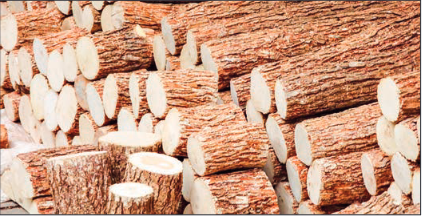
EFFORTS are being made to put the ‘culture of Myanmar’s Thanaka’ into UNESCO’s world intangible cultural heritage list, similar to the traditional Myanmar New Year Atar Thingyan festival, according to the Department of Archaeology and National Museum.
The department is making preparations to submit the ‘culture of Myanmar’s Thanaka’ to the Representative List of the Intangible Cultural Heritage of Humanity of UNESCO by 31 March 2025, and the Form Compilation Task Force started compiling the proposal to the nomination form (ICH-02) from 15 to 17 January.
EFFORTS are being made to put the ‘culture of Myanmar’s Thanaka’ into UNESCO’s world intangible cultural heritage list, similar to the traditional Myanmar New Year Atar Thingyan festival, according to the Department of Archaeology and National Museum.
The department is making preparations to submit the ‘culture of Myanmar’s Thanaka’ to the Representative List of the Intangible Cultural Heritage of Humanity of UNESCO by 31 March 2025, and the Form Compilation Task Force started compiling the proposal to the nomination form (ICH-02) from 15 to 17 January.
Although Myanmar has many intangible cultural heritages, none have yet been listed as part of the World Intangible Cultural Heritage List. However, for over a thousand years, using Myanmar’s Thanaka as the traditional customs and practices have been passed down through generations, and today, the art of Myanmar’s traditional Thanaka remains a significant cultural symbol of the nation and is preserved with care.
Myanmar’s Thanaka was proposed for inclusion in the UNESCO Intangible Cultural Heritage list starting in January 2020, as it aligns with the five criteria for designation as an Intangible Cultural Heritage. —ASH/TTA
Source: The Global New Light of Myanmar
EFFORTS are being made to put the ‘culture of Myanmar’s Thanaka’ into UNESCO’s world intangible cultural heritage list, similar to the traditional Myanmar New Year Atar Thingyan festival, according to the Department of Archaeology and National Museum.
The department is making preparations to submit the ‘culture of Myanmar’s Thanaka’ to the Representative List of the Intangible Cultural Heritage of Humanity of UNESCO by 31 March 2025, and the Form Compilation Task Force started compiling the proposal to the nomination form (ICH-02) from 15 to 17 January.
Although Myanmar has many intangible cultural heritages, none have yet been listed as part of the World Intangible Cultural Heritage List. However, for over a thousand years, using Myanmar’s Thanaka as the traditional customs and practices have been passed down through generations, and today, the art of Myanmar’s traditional Thanaka remains a significant cultural symbol of the nation and is preserved with care.
Myanmar’s Thanaka was proposed for inclusion in the UNESCO Intangible Cultural Heritage list starting in January 2020, as it aligns with the five criteria for designation as an Intangible Cultural Heritage. —ASH/TTA
Source: The Global New Light of Myanmar
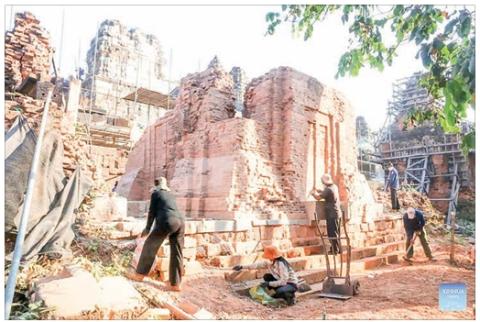
ARCHAEOLOGISTS of Cambodia's APSARA National Authority (ANA) have completed the restoration of Tower 15 at Phnom Bakheng temple in the Angkor Archaeological Park in northwest Siem Reap province, said an ANA's news release on Monday. The ruined brick tower, located south of the ancient Phnom Bakheng temple, is more than 1,000 years old.
ARCHAEOLOGISTS of Cambodia's APSARA National Authority (ANA) have completed the restoration of Tower 15 at Phnom Bakheng temple in the Angkor Archaeological Park in northwest Siem Reap province, said an ANA's news release on Monday. The ruined brick tower, located south of the ancient Phnom Bakheng temple, is more than 1,000 years old. Chhun Ratana, a technical officer from the ANA Department of Conservation of Monuments and Preventive Archaeology, said that before the restoration, Tower 15 had suf fered significant damage, with its roof and walls nearly collapsing due to age and natural elements. She said during the six-month restoration work, the team undertook extensive repairs to reinforce the walls, ceiling, and floor, while also reorganizing the platform to ensure the tower's stability for centuries to come. "The restoration team is now focused on cleaning the site and removing reno vation materials to prepare for the temple's reopening to visitors," Ratana said. "Additionally, plans are underway to initiate a new project aimed at restoring Tower 14, which is situated adjacent to Tower 15," she added. Phnom Bakheng temple is home to 44 brick towers, and thus far, a portion of the site has undergone structural repairs by the ANA in collaboration with the World Monuments Fund, according to the news release. Built in the late ninth century, Phnom Bakheng temple is one of the major temples in the 401-square-kilometre Angkor Archaeological Park, which was inscribed on the World Heritage List of the United Nations Educational, Scientific and Cultural Organization in 1992. — Xinhua
Source: The Global New Light of Myanmar
ARCHAEOLOGISTS of Cambodia's APSARA National Authority (ANA) have completed the restoration of Tower 15 at Phnom Bakheng temple in the Angkor Archaeological Park in northwest Siem Reap province, said an ANA's news release on Monday. The ruined brick tower, located south of the ancient Phnom Bakheng temple, is more than 1,000 years old. Chhun Ratana, a technical officer from the ANA Department of Conservation of Monuments and Preventive Archaeology, said that before the restoration, Tower 15 had suf fered significant damage, with its roof and walls nearly collapsing due to age and natural elements. She said during the six-month restoration work, the team undertook extensive repairs to reinforce the walls, ceiling, and floor, while also reorganizing the platform to ensure the tower's stability for centuries to come. "The restoration team is now focused on cleaning the site and removing reno vation materials to prepare for the temple's reopening to visitors," Ratana said. "Additionally, plans are underway to initiate a new project aimed at restoring Tower 14, which is situated adjacent to Tower 15," she added. Phnom Bakheng temple is home to 44 brick towers, and thus far, a portion of the site has undergone structural repairs by the ANA in collaboration with the World Monuments Fund, according to the news release. Built in the late ninth century, Phnom Bakheng temple is one of the major temples in the 401-square-kilometre Angkor Archaeological Park, which was inscribed on the World Heritage List of the United Nations Educational, Scientific and Cultural Organization in 1992. — Xinhua
Source: The Global New Light of Myanmar
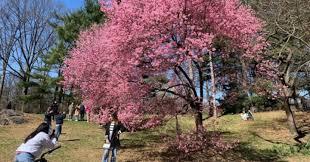
According to the Directorate of Hotels and Tourism (Shan State), the fourth Cherry Blossom Festival is scheduled to take place for five days in January 2025 in Loimwe, Kengtung Township, Shan State (East). The festival was first held in January 2022.
According to the Directorate of Hotels and Tourism (Shan State), the fourth Cherry Blossom Festival is scheduled to take place for five days in January 2025 in Loimwe, Kengtung Township, Shan State (East). The festival was first held in January 2022.
“The festival will be held over five days during the cherry blossom season. The exact dates will depend on the timing of the blossoms, so it is expected to be held in early January. Cherry trees were first planted in this area during the colonial era, and over generations, hundreds more have been added. As a result, the entire forest is covered with cherry blossoms during the season. Around 500 cherry trees were planted around 1990, and another 500 were planted between 2022 and 2023, bringing the total to over 1,000 cherry trees in the Loimwe area,” said U Htin Aung Naing, Director of the Directorate of Hotels and Tourism (Shan State).
The festival will feature traditional dance performances by local ethnic groups, music performances by local singers, and a market offering local products.
In Myanmar, Chin State and Shan State are home to the most cherry trees. In Loimwe, two types of cherry trees –sweet and bitter – bloom alternately, and the cherry blossom season lasts for about a month. Cherry blossom festivals are also held in other Southeast
Asian countries, including Vietnam, and Thailand, and cherry trees are highly regarded in Japan. — ASH/TMT
Source: The Global New Light of Myanmar
According to the Directorate of Hotels and Tourism (Shan State), the fourth Cherry Blossom Festival is scheduled to take place for five days in January 2025 in Loimwe, Kengtung Township, Shan State (East). The festival was first held in January 2022.
“The festival will be held over five days during the cherry blossom season. The exact dates will depend on the timing of the blossoms, so it is expected to be held in early January. Cherry trees were first planted in this area during the colonial era, and over generations, hundreds more have been added. As a result, the entire forest is covered with cherry blossoms during the season. Around 500 cherry trees were planted around 1990, and another 500 were planted between 2022 and 2023, bringing the total to over 1,000 cherry trees in the Loimwe area,” said U Htin Aung Naing, Director of the Directorate of Hotels and Tourism (Shan State).
The festival will feature traditional dance performances by local ethnic groups, music performances by local singers, and a market offering local products.
In Myanmar, Chin State and Shan State are home to the most cherry trees. In Loimwe, two types of cherry trees –sweet and bitter – bloom alternately, and the cherry blossom season lasts for about a month. Cherry blossom festivals are also held in other Southeast
Asian countries, including Vietnam, and Thailand, and cherry trees are highly regarded in Japan. — ASH/TMT
Source: The Global New Light of Myanmar

